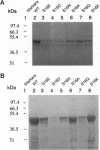Abstract
It was previously proposed that the activation of rat liver phenylalanine hydroxylase (EC 1.14.16.1) by cAMP-dependent protein kinase-mediated phosphorylation of Ser-16 is due to the introduction of the negatively charged phosphate group. To explore the validity of this proposal, we have applied site-directed mutagenesis to specifically replace Ser-16 with negatively charged amino acids, glutamic and aspartic; with polar uncharged amino acids, asparagine and glutamine; with the positively charged amino acid lysine; and with the nonpolar hydrophobic amino acid alanine. The wild-type and mutant enzymes were purified to homogeneity, and the importance of Ser-16 in the activation of phenylalanine hydroxylase was examined by comparing the state of activation of the phosphorylated form of the wild-type hydroxylase with that of the mutants. The kinetic studies carried out on the wild-type phosphorylated hydroxylase showed that all the activation could be accounted for by an increase in Vmax with no change in Km for either phenylalanine or the pterin cofactor. Replacement of Ser-16 with a negatively charged residue, glutamate of aspartate, resulted in the activation of the hydroxylase by 2- to 4-fold, whereas replacement with glutamine, asparagine, lysine, or alanine resulted in a much more modest increase. Further, lysolecithin was found to stimulate the phosphorylated hydroxylase and the mutant enzymes S16E and S16D by a factor of 6-7. In contrast, the mutants S16Q, S16N, and S16A all showed the same magnitude of activation as the wild-type with lysolecithin. Therefore, this study demonstrates that activation of the enzyme by phosphorylation of Ser-16 by cAMP-dependent protein kinase is due to the introduction of negative charge(s) and strongly suggests the involvement of electrostatic interaction between the regulatory and catalytic domains of the hydroxylase.
Full text
PDF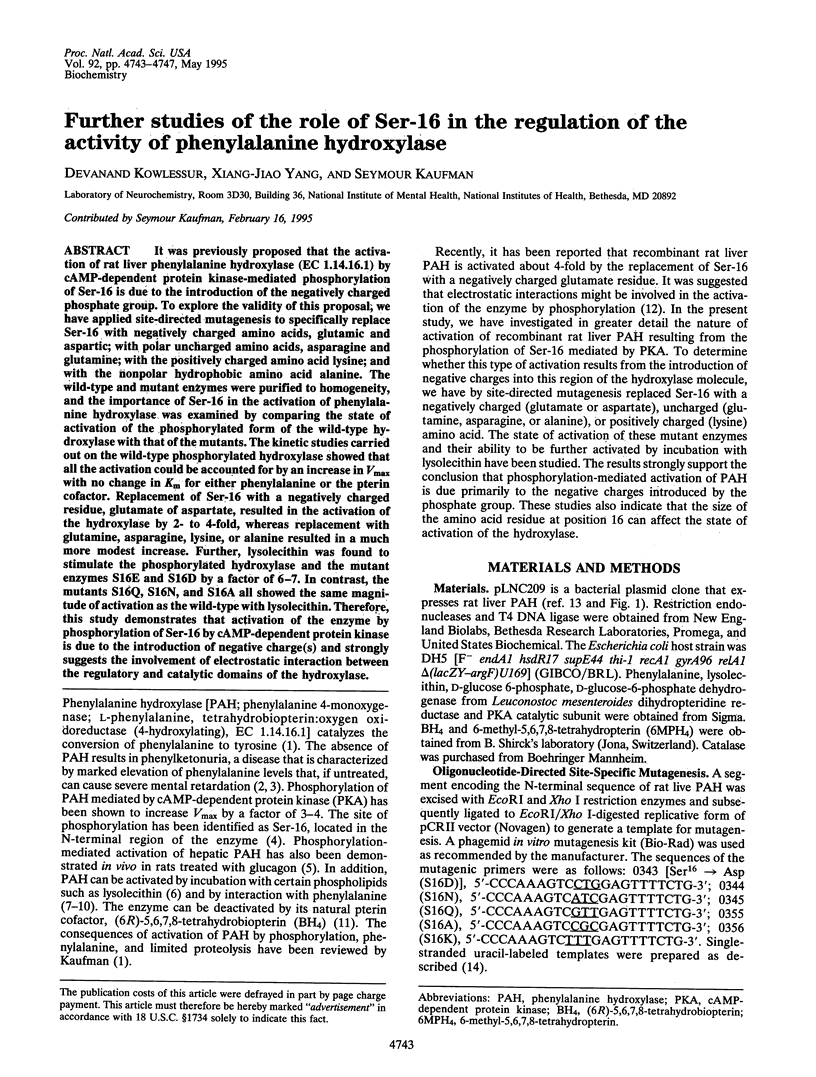
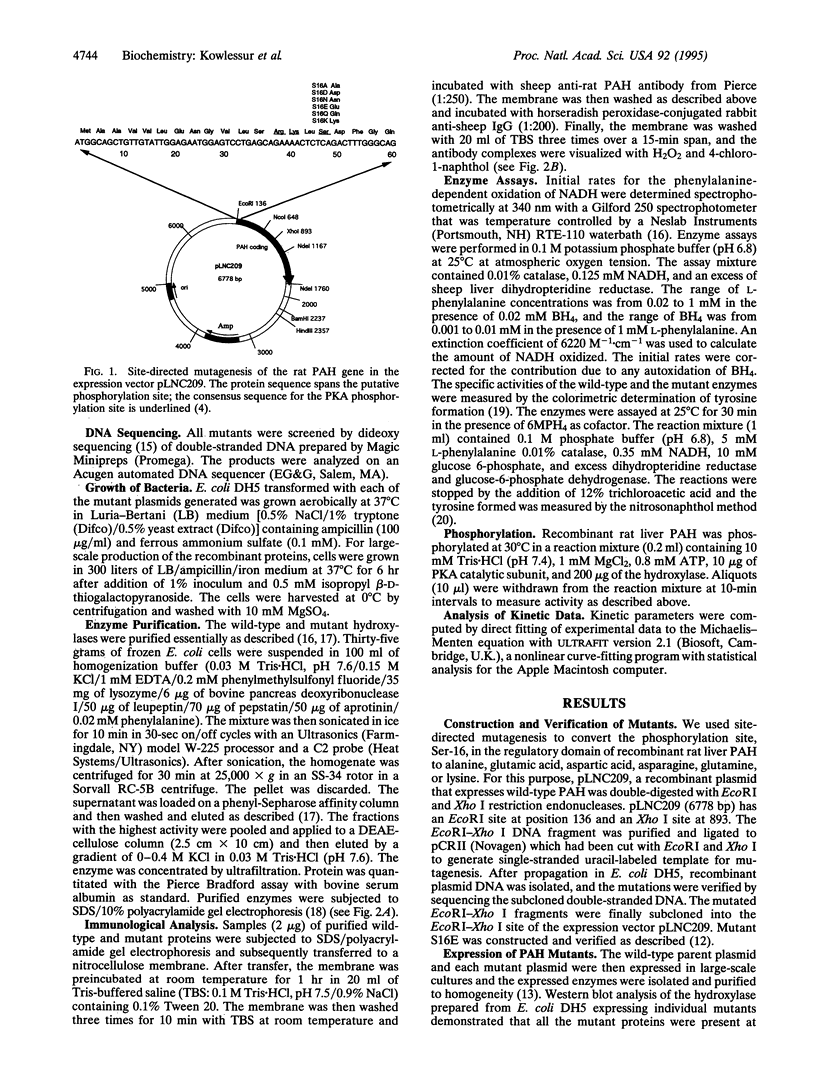
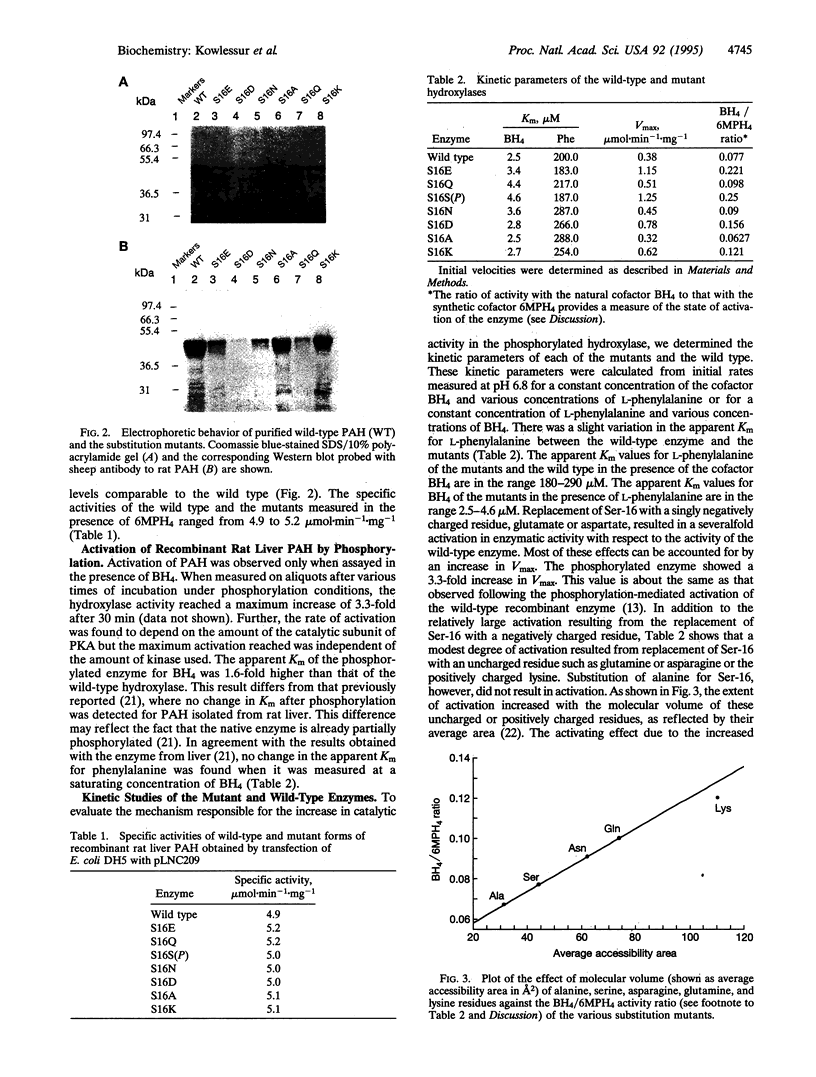
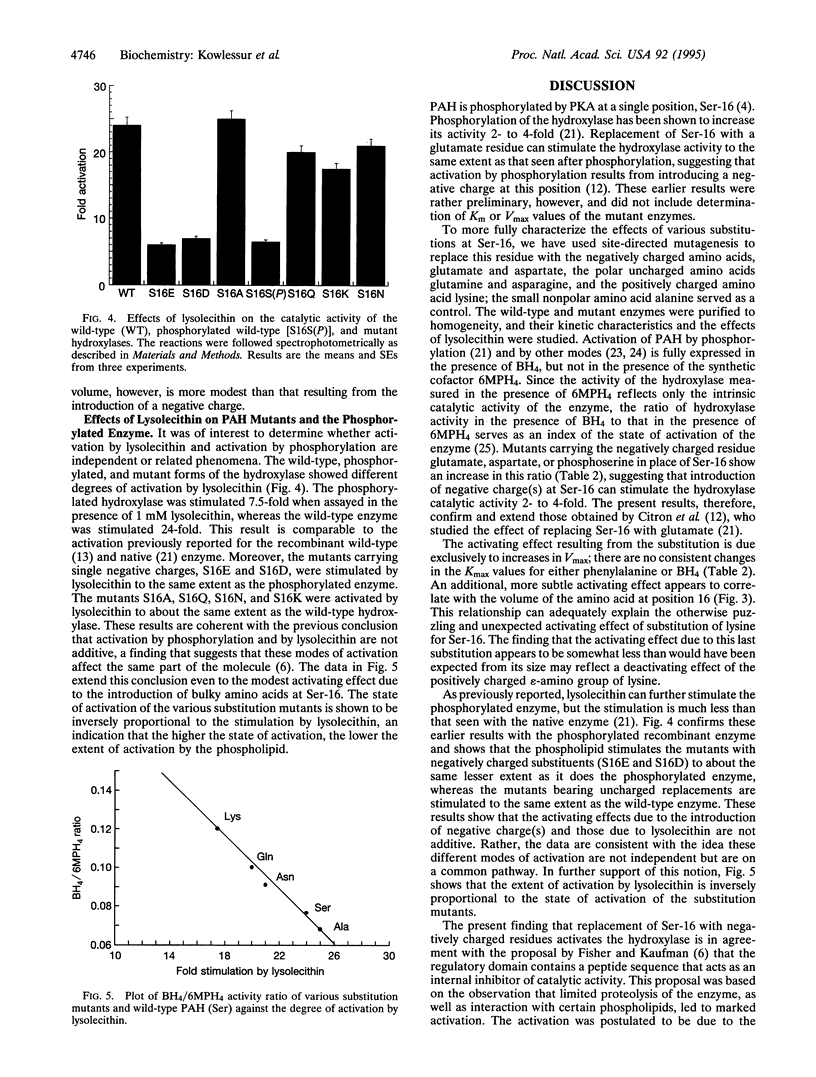
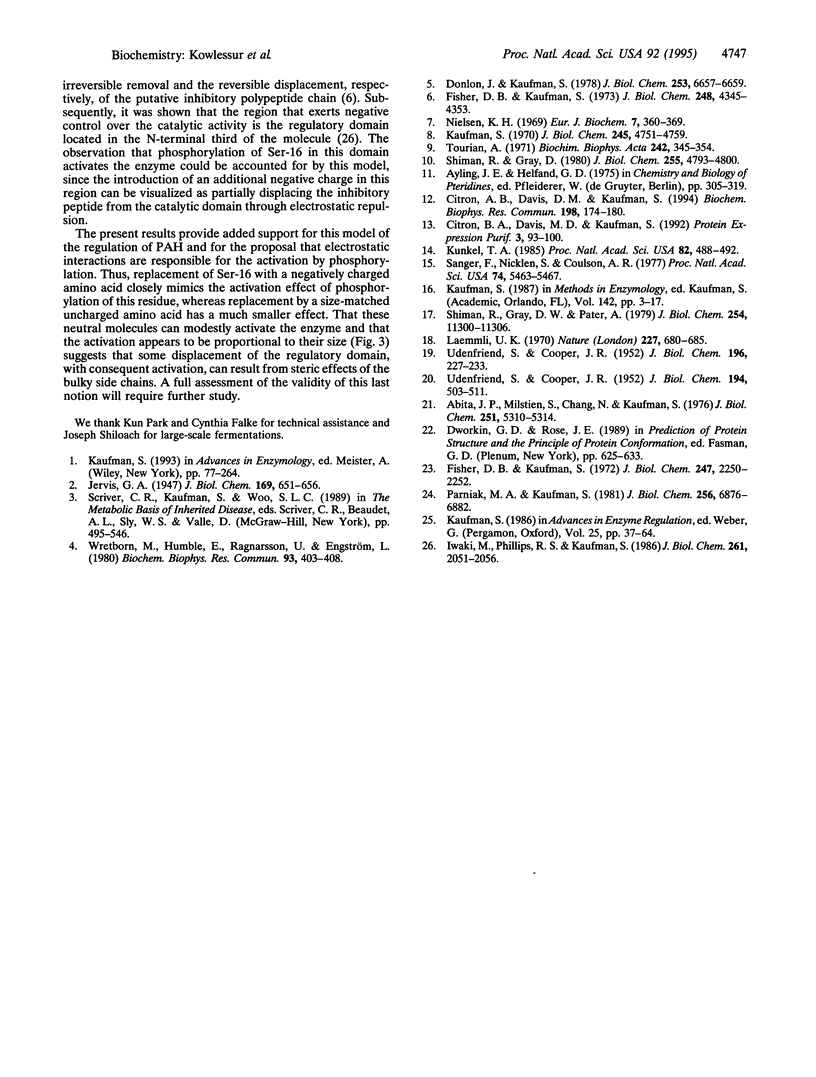
Images in this article
Selected References
These references are in PubMed. This may not be the complete list of references from this article.
- Abita J. P., Milstien S., Chang N., Kaufman S. In vitro activation of rat liver phenylalanine hydroxylase by phosphorylation. J Biol Chem. 1976 Sep 10;251(17):5310–5314. [PubMed] [Google Scholar]
- Citron B. A., Davis M. D., Kaufman S. Electrostatic activation of rat phenylalanine hydroxylase. Biochem Biophys Res Commun. 1994 Jan 14;198(1):174–180. doi: 10.1006/bbrc.1994.1025. [DOI] [PubMed] [Google Scholar]
- Citron B. A., Davis M. D., Kaufman S. Purification and biochemical characterization of recombinant rat liver phenylalanine hydroxylase produced in Escherichia coli. Protein Expr Purif. 1992 Apr;3(2):93–100. [PubMed] [Google Scholar]
- Donlon J., Kaufman S. Glucagon stimulation of rat hepatic phenylalanine hydroxylase through phosphorylation in vivo. J Biol Chem. 1978 Oct 10;253(19):6657–6659. [PubMed] [Google Scholar]
- Fisher D. B., Kaufman S. The stimulation of rat liver phenylalanine hydroxylase by lysolecithin and -chymotrypsin. J Biol Chem. 1973 Jun 25;248(12):4345–4353. [PubMed] [Google Scholar]
- Fisher D. B., Kaufman S. The stimulation of rat liver phenylalanine hydroxylase by phospholipids. J Biol Chem. 1972 Apr 10;247(7):2250–2252. [PubMed] [Google Scholar]
- Iwaki M., Phillips R. S., Kaufman S. Proteolytic modification of the amino-terminal and carboxyl-terminal regions of rat hepatic phenylalanine hydroxylase. J Biol Chem. 1986 Feb 15;261(5):2051–2056. [PubMed] [Google Scholar]
- Kaufman S. A protein that stimulates rat liver phenylalanine hydroxylase. J Biol Chem. 1970 Sep 25;245(18):4751–4759. [PubMed] [Google Scholar]
- Kaufman S. Phenylalanine 4-monooxygenase from rat liver. Methods Enzymol. 1987;142:3–17. doi: 10.1016/s0076-6879(87)42003-x. [DOI] [PubMed] [Google Scholar]
- Kaufman S. Regulation of the activity of hepatic phenylalanine hydroxylase. Adv Enzyme Regul. 1986;25:37–64. doi: 10.1016/0065-2571(86)90007-5. [DOI] [PubMed] [Google Scholar]
- Kunkel T. A. Rapid and efficient site-specific mutagenesis without phenotypic selection. Proc Natl Acad Sci U S A. 1985 Jan;82(2):488–492. doi: 10.1073/pnas.82.2.488. [DOI] [PMC free article] [PubMed] [Google Scholar]
- Laemmli U. K. Cleavage of structural proteins during the assembly of the head of bacteriophage T4. Nature. 1970 Aug 15;227(5259):680–685. doi: 10.1038/227680a0. [DOI] [PubMed] [Google Scholar]
- Nielsen K. H. Rat liver phenylalanine hydroxylase. A method for the measurement of activity, with particular reference to the distinctive features of the enzyme and the pteridine cofactor. Eur J Biochem. 1969 Jan;7(3):360–369. doi: 10.1111/j.1432-1033.1969.tb19617.x. [DOI] [PubMed] [Google Scholar]
- Parniak M. A., Kaufman S. Rat liver phenylalanine hydroxylase. Activation by sulfhydryl modification. J Biol Chem. 1981 Jul 10;256(13):6876–6882. [PubMed] [Google Scholar]
- Sanger F., Nicklen S., Coulson A. R. DNA sequencing with chain-terminating inhibitors. Proc Natl Acad Sci U S A. 1977 Dec;74(12):5463–5467. doi: 10.1073/pnas.74.12.5463. [DOI] [PMC free article] [PubMed] [Google Scholar]
- Shiman R., Gray D. W., Pater A. A simple purification of phenylalanine hydroxylase by substrate-induced hydrophobic chromatography. J Biol Chem. 1979 Nov 25;254(22):11300–11306. [PubMed] [Google Scholar]
- Shiman R., Gray D. W. Substrate activation of phenylalanine hydroxylase. A kinetic characterization. J Biol Chem. 1980 May 25;255(10):4793–4800. [PubMed] [Google Scholar]
- Tourian A. Activation of phenylalanine hydroxylase by phenylalanine. Biochim Biophys Acta. 1971 Aug 20;242(2):345–354. doi: 10.1016/0005-2744(71)90226-9. [DOI] [PubMed] [Google Scholar]
- UDENFRIEND S., COOPER J. R. The chemical estimation of tyrosine and tyramine. J Biol Chem. 1952 May;196(1):227–233. [PubMed] [Google Scholar]
- UDENFRIEND S., COOPER J. R. The enzymatic conversion of phenylalanine to tyrosine. J Biol Chem. 1952 Feb;194(2):503–511. [PubMed] [Google Scholar]
- Wretborn M., Humble E., Ragnarsson U., Engström L. Amino acid sequence at the phosphorylated site of rat liver phenylalanine hydroxylase and phosphorylation of a corresponding synthetic peptide. Biochem Biophys Res Commun. 1980 Mar 28;93(2):403–408. doi: 10.1016/0006-291x(80)91091-8. [DOI] [PubMed] [Google Scholar]



